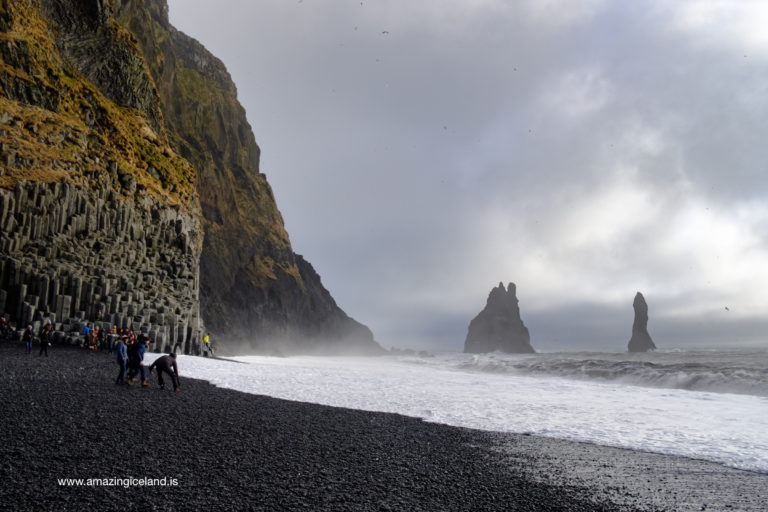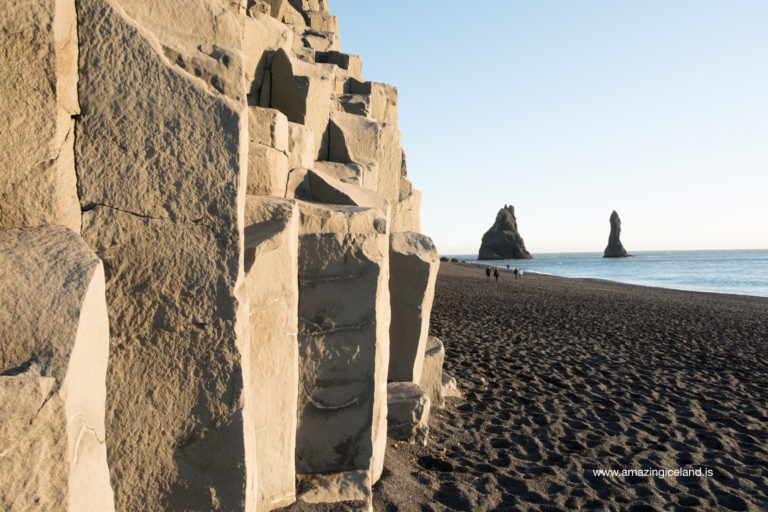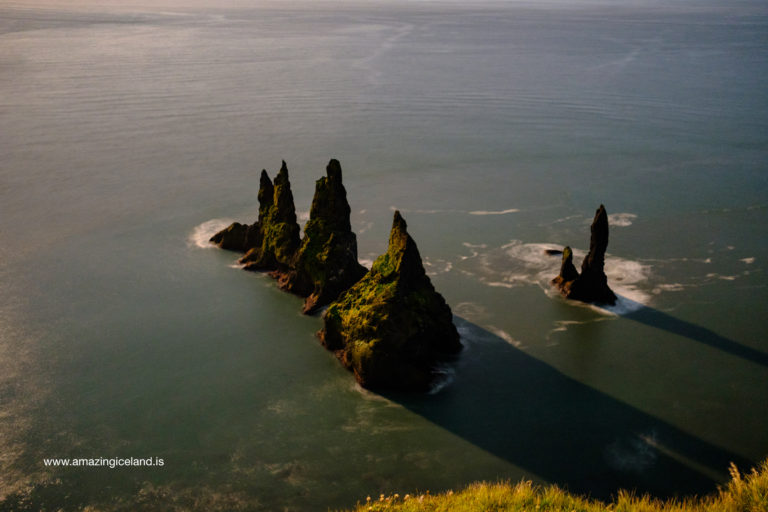
The Reynisdrangar sea stacks are home to thousands of nesting seabirds as well as the cliffs near by. The summer air is filled with wings flapping and birds flying out at see to fish for their young ones. Species that can be found here include Puffins, Arctic tern, Fulmars, Seagulls and Guillemots, making it a interesting location for all birdwatchers out there.
Reynisdrangar sea stacks on the south coast of Iceland
Reynisdrangar are rock formations situated near the shore of Reynisfjara black beach by the coastal village Vík í Mýrdalur on the South Coast of Iceland. The formations are large and impending sea cliffs, made up of the same geological formation as Reynisfjall, mostly basalt. Reynisdrangar serve as a vital part of the area’s allure as they shoot dramatically out of the ocean under the looming cliffs of Mt. Reynisfjall housing thousands of nesting seabirds in summer.
The rock formation
The highest of the rock formation is the 66 m (217 ft) high Langsamur. Attached to Langsamur is Landdrangur, the second largest stack. Landdrangur is the column which is closest to the beach. The third column is the smallest, and is known as Skessudrangur or Háidrangur, this is ironic as both names derive from the Icelandic words enormous and tall.
Reynisdrangar are formed when part of a headland is eroded by hydraulic action, which is the force of the sea or water crashing against the rock. The force of the water weakens cracks in the headland, causing them to later collapse, forming free-standing stacks and even a small island.
Reynisfjall is a 340 m high tuff mountain arising out of a volcanic eruption from under a glacier in the penultimate Ice Age, near the village of Vik. Alternating in an irregular manner are layers of tuff, pillow lava and columnar basalt veins and loops.
Birdlife
The Reynisdrangar sea stacks are home to thousands of nesting seabirds as well as the cliffs near by. The summer air is filled with wings flapping and birds flying out at see to fish for their young ones. Species that can be found here include Puffins, Arctic tern, Fulmars, Seagulls and Guillemots, making it a interesting location for all birdwatchers out there.
Weather and erosion continues to reshape the Reynisdrangar, the cave Hálsanefs cave and Reynisfjara Black beach on a daily basis, the ever changing light and contrast in weather and the elements make sure that when ever you visit the area it will produce unique sights.
The folklore of Reynisdrangar sea stacks.
According to one local Icelandic folklore, these large basalt columns were once trolls engaged in trying to pull ships from the ocean. However, as bad luck would have it, the dawn quickly arose, turning the trolls into solid stone.
Another legend tells of a husband whose wife was kidnapped and killed by two trolls. The man followed the trolls down to Reynisfjara where he froze them, ensuring that they would never kill again.
The third local folk tail claims that these are indeed troll but if you look into it the trolls in Iceland and the trolls in Faeroe islands where trying to pull the two countries to gather, but where turned into stone and therefore you will find the same formations on a beach over in Faeroe islands.
Where are Reynisdrangar rock formations?
Reynisdrangar are located just off the main road on the south coast of Iceland, 180 kilometres east of Reykjavik.
Interesting facts:
The Reynisdrangar sea stacks are home to thousands of nesting seabirds as well as the cliffs near by.
Reynisdrangar are formed when part of a headland is eroded by hydraulic action, which is the force of the sea or water crashing against the rock. The force of the water weakens cracks in the headland, causing them to later collapse, forming free-standing stacks and even a small island.
The Locomotive Elite
What do Donald Trump and Iceland’s Locomotive Elite have in common?
Far more than you think.
In The Locomotive Elite, you’ll uncover how a tiny clique in Iceland captured extensive control—of banks, courts, media, and even the central bank.
For decades they ruled, first democratically, then through corruption and in the end through crime, enriching themselves and their cronies while dismantling oversight.
The result?
One of the most spectacular financial collapses in modern history.














